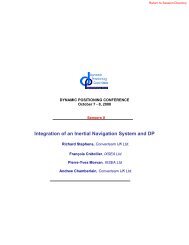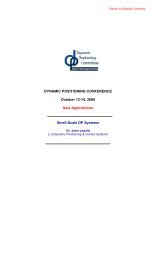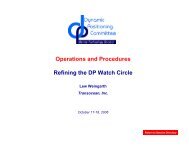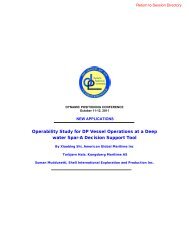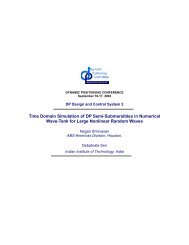Modulated Microwave Position & Heading Reference Sensor
Modulated Microwave Position & Heading Reference Sensor
Modulated Microwave Position & Heading Reference Sensor
Create successful ePaper yourself
Turn your PDF publications into a flip-book with our unique Google optimized e-Paper software.
Author’s Name Name of the Paper SessionDYNAMIC POSITIONING CONFERENCESeptember 16-17, 2003<strong>Sensor</strong>s<strong>Modulated</strong> <strong>Microwave</strong> <strong>Position</strong> & <strong>Heading</strong> <strong>Reference</strong> <strong>Sensor</strong>Jan GrothusenGuidance Control Systems Limited (United Kingdom)
Jan Grothusen, GCS Ltd <strong>Sensor</strong>s <strong>Modulated</strong> <strong>Microwave</strong> <strong>Position</strong> & <strong>Heading</strong>RadarScan – <strong>Modulated</strong> <strong>Microwave</strong> <strong>Position</strong> & <strong>Heading</strong> <strong>Sensor</strong>AbstractFor decades radar has been the principal technology for modern marine safety andnavigation and is trusted and relied upon by mariners everywhere. Obviously the advent of globalsatellite position (GPS) technologies has had an ever-increasing impact and represents animportant functional addition to conventional radar. However, as a position reference sensor(PRS) for vessels with dynamic positioning (DP) capabilities radar has never played a significantrole whereas GPS is virtually always the system of choice even when assisted by further acoustic,laser or mechanical sensors to achieve the required redundancy. Thus the advantages of radarsuch as its independence to difficult weather conditions and its ability to provide local referencemeasurements over significant range have hardly been exploited for DP-controlled stationkeepingapplications such as diving support, supply vessels and shuttle tankers etc.This paper presents an innovative microwave radar PRS providing highly accurate localposition and heading information for any ship-to-ship or ship-to-rig DP application up to 2km inrange. Unlike existing VHF based or active microwave systems this PRS does not require theinstallation and configuration of cumbersome remote transmitters or relay stations. Instead it usestotally passive, compact, lightweight, low-cost and maintenance-free radar retro-reflectorsequivalent to the reflective tape used for laser ranging systems.IntroductionGCS Ltd. have developed a pre-production prototype marine position reference systemconsisting of a frequency modulated continuous wave (FMCW) X-band radar rotating about thevertical axis and sweeping out a plane nominally parallel to the sea. It operates at 9.25 GHz witha 100 MHz bandwidth and measures range and bearing to one or more modulated retro-reflectivetargets. Tracking such targets using an extended Kalman filter the system provides real-timeposition and heading feedback at rates of up to 4 Hz and is in an operational sense very similar toexisting laser position reference systems.The principal idea is that sensor continuously measures range and bearing to beacons of apriori known position or relative geometric constellation to allow for local position and headingestimation. The modulated retro-reflectors maximise return energy in the direction of the sensorand provide a coded return signal to allow for discrimination from background clutter as well asbetween different reflectors. Unlike traditional RACONS the modulated retro-reflectors are"passive" in the sense that they do not transmit themselves but only reflect incidentelectromagnetic energy and are therefore both low-cost and low-power.The radar system has a minimum and maximum range capability of about 20 m and about2000 m respectively. Range and bearing resolution of about 0.1 m and 0.1 mrad can be achieved.Like conventional radar systems the system is mainly immune to environmental conditions andcan operate in cluttered environments.OverviewThe system (see Figure 1) provides a single rotating antenna mounted inside a low lossradome transmitting a pair of vertically polarised frequency-modulated continuous-wave(FMCW) electromagnetic signals of dynamically adaptable sweep ranges depending on the rangediscrimination required. To achieve the required front-end isolation the respective dual receiverfeed chain is aligned for horizontal polarisation. The cross-polarisation of the transmit signalsand the receive signal is crucial as it prevents power leakage between the transmit and receivefeeds at the antenna end, which would otherwise be significant in an FMCW radar system. It isthe responsibility of the transponder to ensure that the required change of polarization is achievedwhen retro-reflecting the incident electromagnetic wave front to the sensor.As shown the radar system is capable of simultaneously processing the receive signalfrom two or more transponders which is a necessity in order to provide local heading informationDynamic <strong>Position</strong>ing Conference September 17-18, 2002 Page 1
Jan Grothusen, GCS Ltd <strong>Sensor</strong>s <strong>Modulated</strong> <strong>Microwave</strong> <strong>Position</strong> & <strong>Heading</strong>in addition to the normal position information. At least three measurements are required to solvefor the three unknown in which case two range and bearing pairs provide sufficient information.TX1TX2RX1RX2∆Hybrid-THybrid-TAntennaEncoderΣdigitalcontrolPowerAmplifierVariableAttenuatorPowerSplitterRF LNAMixerRF LNA MixerPowerSplitterYIGOscillatorLow-PassFilterBase-BandAmplifierNBFilterBase-BandAmplifierautomatic gain controlNBFilterBase-BandAmplifierdigitalcontrolRampModulatorDACADCADCDACADCLow-PassFilterLow-PassFilterNBFilterLow-PassFilterNBFilterdigitalcontrolClutterDetectorEnvelopeDetectorPhaseDetectorup/down ramp synchronizationRay-TraceImageDoppler &RangeEstimateLow-ResBearingEstimateHigh-ResBearingEstimateantenna positionFigure 1: Radar Functional SchematicDynamic <strong>Position</strong>ing Conference September 17-18, 2002 Page 2
Jan Grothusen, GCS Ltd <strong>Sensor</strong>s <strong>Modulated</strong> <strong>Microwave</strong> <strong>Position</strong> & <strong>Heading</strong>The transponders operate at different modulation frequencies and thus superimposeunique temporal codes on the incident transmit signals so that the radar system can easilydistinguish between the receive signal from one transponder and the receive signal from anothertransponder. Equally important, the modulation also helps the radar system to discriminate thereceive signal from the background clutter and for example allows to detect transponders againsta background of steel which would otherwise saturate the front end receiver chain.Additionally, as a result of having two transmit feeds the radar system can use monopulsetechniques to determine a bearing estimate to the transponder on a “per sample” basis in order toreduce the risk that background clutter will seriously degrade the achievable angular resolution.Monopulse is a standard radar technique but is normally only used for antennas that lock on to atarget during operation. Applying monopulse techniques to a rotating antenna has been found togive an improvement in the amount of information that can be obtained in a single scan to obtaina better bearing estimate.It is generally accepted that monopulse techniques do not work well if two targets areclose together. However, because of the unique transponder codes they can be easilydistinguished from each other regardless of their spatial separation. The bearing estimateobtained using the monopulse technique can be used in combination with information about theangular position of the antenna developed using an optical encoder, for example.TransponderThe principal design choice to opt for a retro-reflector type system and not an active kindof transponder (eg RACON) was based on the need to avoid a permanent remote power source.Unlike other RF positioning systems employing active remote stations with permanent powersupplies retro-reflective transponders can be treated like low-cost, discardable and maintenancefree targets such as the retro-reflective tape used for laser systems. They do not require anysetup, tuning or configuration bar the basic fixing at the remote vessel (eg oil rig) within clearview of the operational area.Traditional retro-reflectors, often used as radar target enhancers for yachts and smallcrafts, are derivatives of corner-cubesor Luneberg lenses. However, they allsuffer from their bulkiness as well asthe sometimes insufficiently broadincidence angle performance or deepnulls in their radar cross section (RCS).Instead a Van-Atta (US patent2,908,002) type approach was chosenin a printed circuit-board (PCB)implementation similar to conventionalpatch array antennas. A Van-Atta array(see Figure 2) operating in the far-fieldreconstructs the incidentelectromagnetic wave front sampled atapertures 1–6 when counting equalpath lengths from points A–F, B–E, C–D and reverse based on equal lengthtransmission lines.Figure 2: Van-Atta SchematicFor all practical purposes the equal transmission line length restriction has seriousimplementation problems. Fortunately this has been overcome by breaking this requirement andreplacing it with a more flexible wavelength constraint, which has the side effect of making theVan-Atta array frequency selective (patent application WO 00/59068) and making PCBimplementations possible. Separate PCBs contain the radiating elements and interconnectingwave guide tracks and modulation electronics.Dynamic <strong>Position</strong>ing Conference September 17-18, 2002 Page 3
Jan Grothusen, GCS Ltd <strong>Sensor</strong>s <strong>Modulated</strong> <strong>Microwave</strong> <strong>Position</strong> & <strong>Heading</strong>The preferred solution is a flatpanel similar to a patch antenna withsquare patches as radiating elementsarranged in symmetric sub-arrays (seeFigure 3) and coupled with slot-coupledtransmission lines in a two laminateassembly.Figure 3: Radiating Sub-ArraySuch elements can be optimized for their frequency response and polarization to ensureperfect operation with the radar system without affecting other radar systems. More importantlythe azimuth and elevation gains can be traded-off against each other to achieve the optimum RCSin each direction. Based on the effective area of the sub-array elements the theoretical peak gaincan be calculated at around 8 dBi however this hides the more important fact that in the verticalcut the RCS is purely defined by the aperture of a single square patch and therefore results in avery favourable flat and broad response (±60 degrees, see Figure 4). In the orthogonal cutdirection, corresponding to the elevation illumination, a much narrower (±10 degrees) half-powerbeam width is a result of the aperture of the overall sub-array. Extrapolating the gain figures forthe sub-array an overall RCS of 5m 2 can be achieved with a total of 40 sub-arrays over the smallarea of 350mm x 220mm. Other configurations with even higher overall RCS figures can beachieved.20100Gain (dBi)-10H ElevationV ElevationH AzimuthV Azimuth-20-30-40-100 -80 -60 -40 -20 0 20 40 60 80 100Angle from boresight (degrees)Figure 4: Gain with bore-sight for each polarizationThe superimposition of a unique temporal code onto the retro-reflected energy isachieved by the incorporation of suitable high-frequency pin-diodes directly onto the waveguidesetched into the board laminate (see Figure 5). Thus phase or amplitude modulation areequally feasible, while the former is the simplest when employing digital monotone modulationas this has the added benefit of suppressing half the sidelobes. Very little power is required forthis purpose allowing long-term operation on a small embedded battery as the pin-diodes can beswitched with only a few µA of bias current. The use of sub-arrays has the added benefit ofreducing the number of transmission lines, the overall return losses and the number of pin-diodesrequired, so that only a small number of diodes need to be employed even in modest transponderDynamic <strong>Position</strong>ing Conference September 17-18, 2002 Page 4
Jan Grothusen, GCS Ltd <strong>Sensor</strong>s <strong>Modulated</strong> <strong>Microwave</strong> <strong>Position</strong> & <strong>Heading</strong>assemblies. Care needs to be taken to reduce theinsertion losses and to ensure no RF leakage into thedriver circuit consisting of a small number of standardCMOS semiconductors.Radar <strong>Sensor</strong>With reference to Figure 1, the radar system isdriven by a YIG oscillator providing a 9.2-9.3 GHz (Xband)signal which is modulated by a DAC rampmodulator and fed through a power splitter, a variableattenuator and a 35dB power amplifier to a hybrid Twhere it is divided to create the two transmit feeds TX1and TX2 in vertical polarization.Figure 5: Microscope view of diodeThe reflected signal is received at the rotating antenna by two spatially separated receivefeeds RX1 and RX2 and combined in a hybrid T giving a Σ and ∆ output. The sum output andthe difference output are fed into separate mixers where they are mixed down with the transmitfeed from the power splitter to the intermediate frequency (IF) stage. The IF signals are filteredusing narrowband 0.5 MHz filters to remove background clutter and to separate out the signalsreturned by each of the transponders, amplified using base-band amplifiers and fed into a quad-DSP system. The passband filters are specifically chosen to match groups of differenttransponder modulation frequencies.The mixed signal from the sum output is also filtered using a low-pass filter to isolate thebackground clutter and amplified using a base-band amplifier. The processing system uses thissignal to produce a 360° trace image which can be used to provide a background image on theoperator display giving a visual ray-trace of the environment.The filtering and amplification is carried out separately for each of transpondermodulation frequencies and the filtering and amplification can be hardware or software baseddepending on the degree offlexibility that is required and theprocessing power available.The usual pre-filtering,down-conversion, normalization andfrequency analysis is performed todetermine a range and bearingestimate. The processing is carriedout using an envelope detector and aphase sensitive detector, both ofwhich use information about theangular position of the antennadeveloped by an optical encoder.Analysis of the power spectrum inthe frequency domain (see Figure 6)clearly shows the up- & down-ramppeaks corresponding to individualtransponders.Figure 6: Two target power spectrumThe frequency difference between the two peaks centered on the nominal modulationfrequency corresponds directly to the range to the target as in conventional FMCW systems (seeFigure 7) and can be recovered using standard FFT and constant false alarm (CFAR) analysistechniques. The bearing estimation operates similarly except that because of the monopulseapproach glint effects can be reduced and the standard optical encoder resolution can be improvedupon by performing zero-crossing analysis of the phase sensitive detector output as well asintegrating the envelope detector output.Dynamic <strong>Position</strong>ing Conference September 17-18, 2002 Page 5
Jan Grothusen, GCS Ltd <strong>Sensor</strong>s <strong>Modulated</strong> <strong>Microwave</strong> <strong>Position</strong> & <strong>Heading</strong>The transponder modulation productsare deliberately spaced to avoid crosscontamination with low range clutter whilestaying within the bandwidth capabilities ofthe transponder (see Figure 8).The clutter rejection performs welland can even cope with narrowly spacedtargets where due to the antenna beam widthboth targets are simultaneously illuminatedacross a sweep (see Figure 9).The DAC ramp modulator producesa saw-tooth analogue ramp signal, which isused to derive a digital direction signal andfed into the processing system to determinethe velocity of the antenna relative to each ofthe transponders using Doppler techniques. Figure 7: Target at 130m range (∆ ±40 kHz)The system can thus not only resolve position and bearing to a number of uniquetransponders but also velocity vectors in the direction of each target. This can be combined in anextended Kalman filter to track the targets taking account of wave motion and vessel ego-motionto provide an accurate and real-time local position and heading update at up to 4 Hz. Thediscussion of these DSP algorithms and the Kalman filter are beyond the scope of this paper.Figure 8: IF spectrum200150100500-50-100-150-2000 0.002 0.004 0.006 0.008 0.01 0.012 0.014 0.016 0.018Figure 9: Time domain waveform and power spectrum analysis of twonarrowly spaced targets against a background of radar clutter.Dynamic <strong>Position</strong>ing Conference September 17-18, 2002 Page 6
Jan Grothusen, GCS Ltd <strong>Sensor</strong>s <strong>Modulated</strong> <strong>Microwave</strong> <strong>Position</strong> & <strong>Heading</strong>ConclusionsThe sea-worthy prototype implementation has 5W of transmit power and is fully enclosedin a sealed radome (see Figure 10) and fitted with a heater and pressure compensation seals. Theembedded real-time control system is based on four low-cost 100 MHz DSPs with 600 MFLOPseach, two 65 MS/s 12-bit A/D and a 100 MHz FPGA front-end integrated into a single boardcoupled with an embedded PC on a common PCI interface. The PC is responsible for running theactual navigation algorithms and a networked user-front end while the DSP front-end controls thedata acquisition and the real-time number crunching. The system is expected to be undergoingsea-trials by the time of publication with production engineering commencing forthwith.Figure 10: Prototype (housed and open) prior to sea-trialsContact DetailsFor further details please contact in the first instance the author, Jan Grothusen, at:Guidance Control Systems Ltd.4 Dominus WayMeridian Business ParkLeicester, LE19 1RPUnited KingdomEmail: jan@gcsltd.co.ukWeb: www.gcsltd.co.ukPhone: +44 (0)116 229 2603Fax: +44 (0)116 229 2604Dynamic <strong>Position</strong>ing Conference September 17-18, 2002 Page 7



